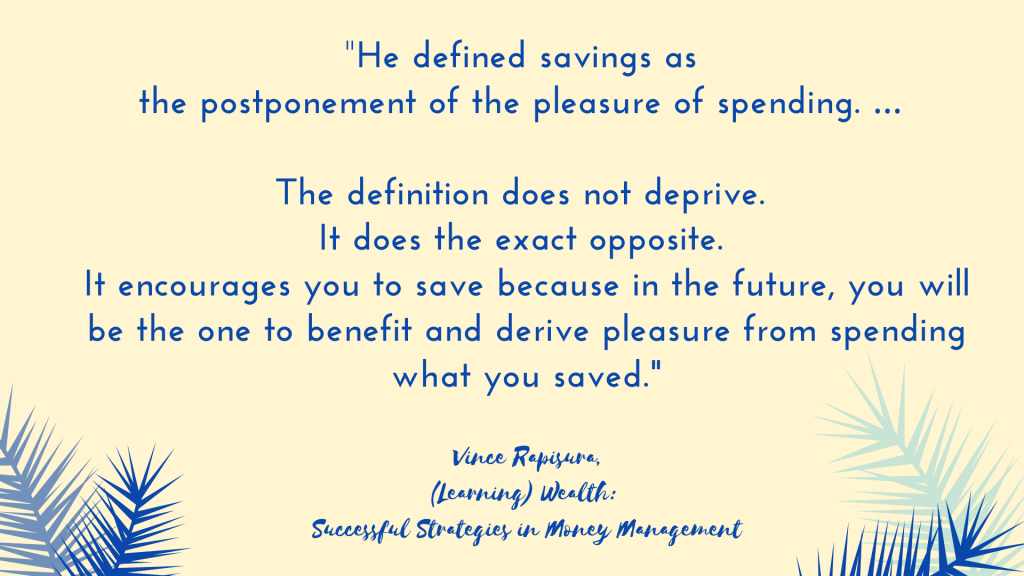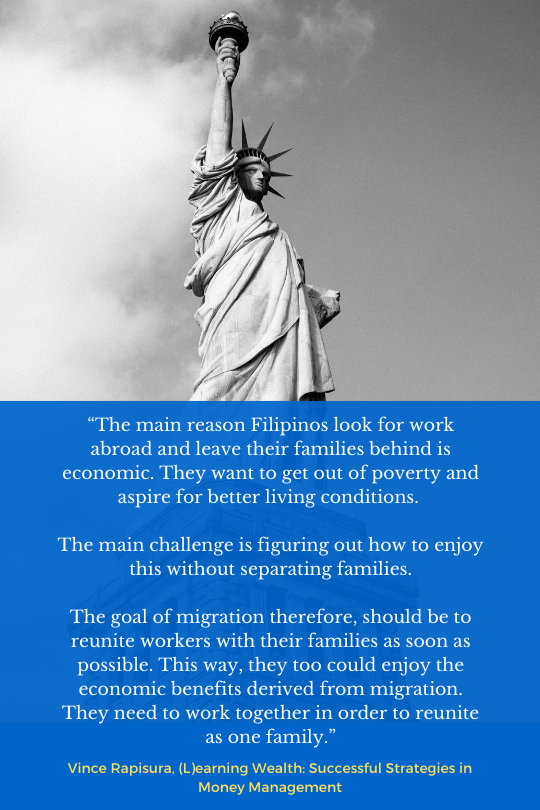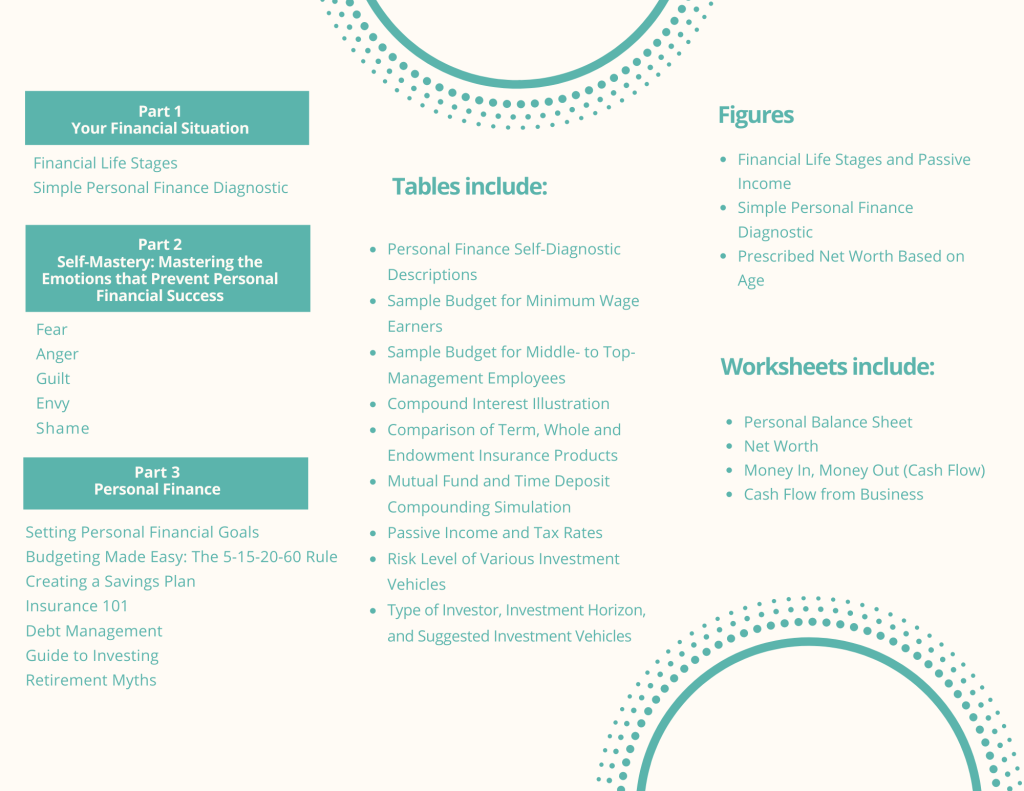Income – Expenses, I thought, that’s the equation for savings.
But according to Sir Vince Rapisura it’s not.
I also remember him asking how low-income individuals could save. Well, if that first equation was wrong, the answer must be: They can’t, I told myself. They don’t even earn enough to cover basic needs!
I should know better. I was a full scholar in college, we were barely making ends meet. Savings can’t be part of the equation. To me, that’s simply a reality.
But Sir Rapisura had an answer: Income – Savings = Expenses.
“One of the misconceptions about the poor is that they cannot and do not save. The poor can and do save, albeit in small amounts.” ~ Vince Rapisura
And darn, it’s hard to imagine and even harder to do. I buried that equation in my subconscious until a few years ago when one of my friends told me I can start investing in small amounts.
I started attending free seminars (some of which were very informative, others were more promotional), listening to podcasts, and reading books and articles.
While there are A LOT of materials out there, I wanted ones that were written for Filipinos. And specific steps that did not require huge investments. Something beginners in personal finance would understand. Something actionable even for ordinary Filipinos who do not have huge bank accounts or fat paychecks.
I felt like Sir Rapisura’s book (Learning) Wealth: Successful Strategies in Money Management were all these things and more. When I began reading it, I placed post-its on pages I wanted to share in this blog. After a while, I realized the post-its were pointless. If I include all those in a blog post, I’d be copying a good portion of the book! (I swear, this book should be a required reading in college!)
So here, I’m just going to include some of my favorite lessons from the book and my reflections.
1. 5-15-20-60 Rule in Budgeting
I’m not a fan of math, but this equation is very important. And maybe the second most important after the MDAS rule. 😛 (But seriously, I wish this was taught in school. That way, Filipino children can start developing good financial habits, and be prepared to manage their money once they start earning.)
Sir Rapisura suggests the 5-15-20-60 rule when budgeting your monthly income (gross salary):
- 5% for insurance
- 15% for savings
- 20% for debt payments
- 60% for expenses
He encourages first protecting yourself (through insurance) as you are “your most valuable asset.” (I so agree! Whoever you are, I hope you are taking good care of yourself.) In a separate chapter, he dives into greater detail on insurance types and terms, and knowing which one may better fit your needs.
In terms of emergency savings, he recommends setting aside funds equivalent to nine months of your expenses or six months of your income.
Those who don’t have debt payments (20%) can put their funds in investments. Mr. Rapisura advises studying each investment and looking at the risks.
He also provides a risk level table for different investment vehicles, and budget simulations for minimum wage earners, microentrepreneurs, middle- to top-management employees, self-employed professionals, and temporary migrants.
Different personal finance books share different budgeting formulas. For instance, Bo Sanchez, in his book How Good People Like You Can Become Rich, suggests having 7 jars:
- Eternity Fund/Tithes (10%)
- Education Fund (5%)
- Enjoyment Fund (5%)
- Empower Fund (5%)
- Emergency Fund (5%)
- Emancipation/Retirement (20%)
- Everyday Fund (50%)
I wrote more about these budgeting rules in this post. The allocations may vary, but what these budgeting rules have in common (aside from the expenses jar) is the need to save–for emergencies, for investments, and for things we want to enjoy in the future.
2. The Five Financial Life Stages
The book also covers the five financial life stages based on how much of your expenses can be covered by your passive income (i.e., earnings from investments).
At the financial start-up stage (which is where most of us began), 100% of our expenses comes from our active income (i.e., from our full-time, part-time, and freelance gigs). As we move through the financial stages (financial independence, financial growth, and financial stabilization), our passive income grows. Finally, when we reach financial freedom, our passive income either equals or exceeds our expenses.
I never really thought of financial life stages from a passive income perspective. I thought about it more in terms of age and increasing active income as you progress in your career.
While growing one’s active income isn’t bad, focusing solely on it means we’re unable to leverage other income streams that could help us reach our financial goals faster. There are instruments where our money will work for us, while we are busy living life, building businesses, or growing our careers.
To me, maximizing both active and passive income streams calls us to work hard AND be smart about where we invest our time, money, and energy.
“Active income as a percentage of expenses decreases as one progresses in the financial life stages.” ~ Vince Rapisura
3. How the fear of not being loved can affect our personal financial success
Perhaps many of us had been in a position wherein a loved one asks for something, or needs help. We couldn’t afford it, but we are willing to get into debt just to give it.
Or we kept giving, leaving little to none for ourselves. Or our giving led another to pursue a lifestyle we couldn’t sustain, or neglect their responsibility for their own well-being.
The book discusses how Filipinos’ fear of not being loved can have negative impacts on both the giver and the receiver. Sir Rapisura reminds readers that “love is making the other grow.” So if our actions make our loved ones dependent on us for things they should be doing for themselves, then it is no longer a loving act.
4. Developing a positive attitude toward saving
When I tried to get into the habit of saving, it was hard. It felt like deprivation. I had to skip a lot of whims and say no to others and to myself.
It had been a struggle, and it still is. But saving a little at a time has allowed me to make more progress financially.
I know what it’s like to get sick with little to no emergency fund (which is a very painful experience I wouldn’t wish on anyone). And now I already know what it’s like to have something stashed away for emergencies.
That felt good. Even if I was still struggling financially, knowing I could take care of myself when I got sick gave me some peace of mind.
I know what it’s like to want to give nice gifts, and save for these months ahead so I do not have to break my budget.
I’ve had times when I tell myself, “Remember we just bought ourselves a reward? We’ll buy another next time. We’ll save for it.”
And passing by a bag, dress, or gadget I want, I would reassure myself: “I can afford you. But I’m saving up for something more important that will also make me happy (or happier).”
The book highlights how important it is to be optimistic about life and have a positive view of saving, one that highlights the benefits of saving without painting spending as “bad.” I learned that if I save for something, I can spend the money later on guilt-free. But when I break my budget because I was feeling low or I couldn’t say no to someone, well, I come home trying to justify the expenses to myself.

5. Insurance as a way to mitigate risks, and things to consider before buying insurance products
A chapter of the book is dedicated to insurance and its role in mitigating risks. It also discusses different insurance premium payments, naming beneficiaries in insurance policies, insurance vs. pre-need plans, life and non-life insurance products, and how much insurance one needs (without dependents and with dependents). In the section on retirement myths, Mr. Rapisura also addresses people’s misconceptions that a lot of insurance companies have closed when in fact, they are referring to pre-need companies.
With all the insurance products out there, deciding which one to go for can be confusing. This book can help clear up some of the confusion and give you points to consider before choosing an insurance product. It also has tables showing sample computations when investing via variable life insurance, time deposits, and mutual funds or UITFs.
“It is in your best interest to separate insurance and investments.” ~ Vince Rapisura
6. Investing has tax benefits
Aside from the possibility of generating income, investing offers lower tax rates. Sir Rapisura points out that the maximum tax rate for personal income is 32% while for investment income, it’s 20%.
7. Increasing your financial literacy, and growing your funds a step at a time
Just like many Filipinos, I used to think that you need LOTS of money to invest. But as Mr. Rapisura pointed out in the book, we can begin investing with small amounts. Even the act of opening a savings account is already a form of investing.
“People always have the impression that you need a lot of money to invest. This is a myth. You can start investing with small amounts starting with opening a savings account.” ~ Vince Rapisura
We can start with opening one savings account and following the 5-15-20-60 rule. While at this phase, we can start studying investment vehicles such as bonds, mutual funds, and UITFs. Eventually, we can start our own business or invest in another’s business.
“You should be able to understand the business you are investing in even if you are not involved in the day-to-day operations of the business.” ~ Vince Rapisura
Setting financial targets
I started this blog because of my own financial journey. And after reading Sir Rapisura’s book, I realized that it’s not enough to just aim for “financial literacy, empowerment, or financial freedom.” I have to write exactly how much my goals cost so I would know how far, or close, I am to achieving them and what/where I need to adjust.
Is it scary? YES. I know what it’s like to plan, work so hard, and then fall flat on your face. But it’s also true that the lessons you learn will help you get back up much faster.
A quick Google search will even show you a long list of entrepreneurs and celebrities who failed a lot before becoming successful. So even if we fail, well, let’s just say we’re in good company. After shedding a tear, we dust ourselves off and start over.
It’s never just about the money
Sir Rapisura shares another strategy to make saving easier: knowing WHY we do it. Our WHY then serves as our inspiration to save.
And not just to save. In my case, my WHY’s have motivated me to take a hard look at my earnings and habits, and start getting my financial house in order. Because it’s NEVER just about the money. Money is just a tool we use to help us take care of ourselves, give to the people we love, and share to causes we believe in. Those are my WHYs.
What are yours?

A Preview of the Contents of (Learning) Wealth: Successful Strategies in Money Management


